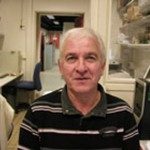Link to Pubmed [PMID] – 25881166
PLoS ONE 2015;10(4):e0124400
Infection with Plasmodium knowlesi, a zoonotic primate malaria, is a growing human health problem in Southeast Asia. P. knowlesi is being used in malaria vaccine studies, and a number of proteins are being considered as candidate malaria vaccine antigens, including the Apical Membrane Antigen 1 (AMA1). In order to determine genetic diversity of the ama1 gene and to identify epitopes of AMA1 under strongest immune selection, the ama1 gene of 52 P. knowlesi isolates derived from human infections was sequenced. Sequence analysis of isolates from two geographically isolated regions in Sarawak showed that polymorphism in the protein is low compared to that of AMA1 of the major human malaria parasites, P. falciparum and P. vivax. Although the number of haplotypes was 27, the frequency of mutations at the majority of the polymorphic positions was low, and only six positions had a variance frequency higher than 10%. Only two positions had more than one alternative amino acid. Interestingly, three of the high-frequency polymorphic sites correspond to invariant sites in PfAMA1 or PvAMA1. Statistically significant differences in the quantity of three of the six high frequency mutations were observed between the two regions. These analyses suggest that the pkama1 gene is not under balancing selection, as observed for pfama1 and pvama1, and that the PkAMA1 protein is not a primary target for protective humoral immune responses in their reservoir macaque hosts, unlike PfAMA1 and PvAMA1 in humans. The low level of polymorphism justifies the development of a single allele PkAMA1-based vaccine.


